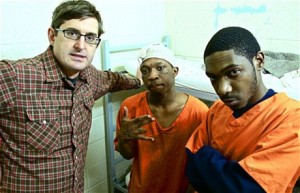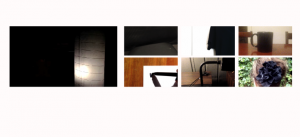Myself and a team of students that are undertaking Integrated Media 1 have produced a short Korsakow film, I’Object.
The film focuses on Bordwell’s concept – “It is possible to organise an entire film around colours, shapes, sizes and movements within the images”.
(Bordwell, Thompson. 2013, p11)
Here is our critical statement for our film, which is our final major essay for the specialisation subject. The piece is written by Simon Topin with contributions from myself, Ed Goldsmith and Daina Anderson.
CONTENT
The Korsakow project entitled ‘I, Object’, attempts to take non-linear, non-narrative based theories to their logical conclusions. To this end, we deliberately avoided trying to tell any kind of story and used six household objects; chairs, mugs, fascinators, textas, clothes and lamps, presenting each object in ten different colours across the spectrum; red, yellow, pink, green, purple, orange, blue, white, black and grey. The film is a list within a list, where everything is neatly categorised and understood. Everything is only what it seems and the disparity between the objects and the rigid order of the colour system attempts to subvert any emergent narrative or subtext within the work. This attempt at authorial invisibility speaks of “infinite possibilities in combining and making connections across a networked field of elements”, (Frankham. 2013, p138) where the seeming randomness of the objects in the list, and their adherence to a colour code means that they are in themselves meaningless – literally any object of an appropriate colour could be substituted to replace them.
Like the medieval perception of time, ‘I, Object’, runs on an infinite loop. By embracing the list form totally, the film aims to reduce itself to “sequential notations of temporal events with no meta-historical, narrative prefiguration. So, we get a glimpse of a way of processing cultural experience that does not need stories”. (Ernst. 2003, p42) However, in a 20th century obsessed with stories and comprised of individual, marketing assisted narratives, this glimpse must remain fleeting.
“Associational formal systems suggest ideas and expressive qualities by grouping images that may not have any immediate logical connection. But the very fact that the images and sounds are juxtaposed prods us to look for some connection – as association that binds them together”. (Bordwell and Thompson. 2008, p363)
The tension of list vs narrative is expressed, again literally, through the choice of soundtrack. The industrial and largely atonal electronic soundscape is intentionally aggressive and challenging, contrasting the domesticity of the objects in the film.
The grinding progression of the music accompanied by the infinite loop and eventual ‘living death’ that takes hold of the film prompts the viewer to try and forget themselves, to become one with the never-ending progression of objects, to be absorbed self-consciously into an “institutional matrix represented in time”. (Frankham. 2013, p139)
PATTERN
The pattern moves through a sequential progression of colours. Starting as a solid block, six different objects sit next to the previously selected object of their triggering colour.
A gradual decay in the lifespan of the individual films comprising ‘I, Object’, alters the Korsakow viewing space until the form becomes repeating and static. By observing this, it would be easy to infer metaphors about the de-humanising narratives of consumer capitalism, planned obsolescence and the commodification of spaces, but this was not an intention of the film. Closer to the mark, the film is a kind of parody, expressing doubts about what Bogost calls, “the jarring staccato of real being”, (Bogost. 2012) that assumes “real being”, whatever it is, has no organising principle and therefore narrative. In other words, we dispute that any notion of story is itself a false and ‘human’ construction. Were humans to suddenly evaporate from the planet, cause and effect would still occur, whether we are there to observe it or not, so to this end, this film is a self-conscious attempt at falsehood, acknowledging the inevitable attempts of the viewer to create meaning, while disavowing any interpretation that goes beyond the colours of the banal objects. This is highlighted through the close up shots that “isolate the objects from their everyday context in such a way that their abstract qualities come forward”. (Bordwell and Thompson. 2013, p12)
INTERFACE
There is a limited amount to be said about the Korsakow interface that hasn’t been somehow addressed in the ‘Pattern’ and ‘Content’ sections. An initial test suggested that users are encouraged to follow each separate object through its ten different colour iterations. Thematically, this is encouraging and supports Frankham’s claim that, relationships are formed through “conceptual alignment, emotional impact, visual similarities and territories of gesture”. (Frankham. 2013, p138)
We selected the decay rate of the videos based on what we judged to be their aesthetic value. Pens and fascinators, being the most interesting, are infinite, lamps have two lives and mugs, chairs and clothes have one life each. This will create a degree of controlled randomisation in the way that the interface is expressed. Unless the viewer follows exact paths, the interface layouts will be inconsistent – in line with our intentions. One potential drawback of the film is its replay value, and may not prompt the participant to explore the work to its end, yet this in itself may not be a problem, as the film can be started or finished at essentially any point.
CONCLUSION
Our film is very high concept and deliberately conforms to the machine-logic of modern media studies. That is, the logic of fetishized transhumanism that eschews narrative and expects that in a computerised age, humans must by necessity now resemble machines internally – as silicon based Monads – impersonal, democratised nodes of existence. ‘I, Object’ attempts to convey the aggravating nihilism of this approach, while simultaneously acknowledging the beauty in pure aesthetics.
However, ‘I, Object’, remains aware of the impossibility of removing completely either the viewer or the author from the equation, and expresses this through the juxtaposition of harsh electronic noise and boring household items. ‘I, Object’s’ passive rigidity goes against both notions of randomness and narrative, (a story in itself?) yet retains the potential to tell whatever story the viewer desires. Our cataloguing of images “help to describe part of external reality”, (Bogust. 2012, p42) although what reality this is exactly, remains unspecified.
Ultimately, in spite of our attempts to subvert narrative and meaning, “if the film’s formal organisation has been created with care, the similarities and differences will not be random. There will be some underlying principle that runs through the film”. (Bordwell and Thompson. 2013, p12)
1100 Words
References:
Bogost, Ian. (2012) ‘Alien Phenomenology, or What It’s Like to Be a Thing’. Minneapolis: University Press of Minnesota. Print.
Bordwell, David, and Kristin Thompson.(2013)‘Film Art: An Introduction’. New York, N.Y.: McGraw-Hill.
Ernst, Wolfgang ;Méchoulan, Éric (Editor) ; Cisneros, James (Guesteditor) ; Garneau, Michèle (Guesteditor) (2003) ‘Telling versus Counting? A Media-Archaelogical Point of View’, Intermédialités, pp.31-44
Frankham, Bettina Louise. (2013) ‘Complexity, Flux and Webs of Connection. A Poetic Approach to Documentary : Discomfort of Form, Rhetorical Strategies and Aesthetic Experience’. PhD Dissertation, University of Technology Sydney.

